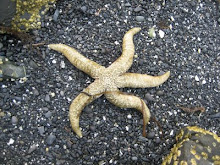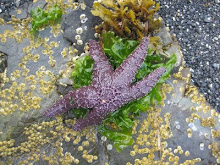This info comes from wikiPOBia and explains the meaning of the word Marlinspike. It is a website that explains the nautical terminology in Patrick O'Brian novels. The photo below shows a rigging knife with a marlinspike that was given to me by an old friend from Sitka, Alaska. His name was Bud Nave. He was a farmer from Idaho who after visiting Alaska decided to stay. I helped him clean out a storage closet and he gave me the knife. I told him that he should give it to a grandson or family member but he insisted on giving it to me. I suppose he knew that I was a skipper and would appreciate the Marlinspike. I learned to splice and tie knots in Guam and have always appreciated the marlinspike for splicing and untying tight knots.
The knife is next to a Marlinspike seashell that I collected while living in Guam. You can always tell where a Marlinspike is under the sand in the shallow reefs by the trail across the sand. I spent many fun hours snorkeling around Piti Bomb Holes on Guam searching for them.
You would find them by following the trail in the sand until it ended, then reaching down into the sand and feeling around for the shell.
I remember someone coming into the dive shop on Guam that was across the street from the Piti Bomb Holes and told us that there was a rescue going on down the street. I took off running and when I got to the place where there were people gathered I looked out and saw some rescuers bringing in a body on a surf board. I ran out in the water to meet them and as I got close I could see that they were trying to do CPR. I jumped in and started helping and asked them if they had given mouth to mouth. They said that they had but didn't have a shield. I remember thinking that this guy was going to die and so I started giving him mouth to mouth. All the time we were doing this we were dragging him to the beach. It was very difficult because when we would give him chest compressions we would push the board down into the water. One of us would do mouth to mouth or compressions while another slowly pulled the board into the beach while the other held the board from sinking down from the chest compressions. I remember how hard it was to keep the guys flexible lips from moving and letting air escape when I was doing mouth to mouth. Finally we got to the beach. Soon the paramedics were there. They quickly put a machine on him to see what his vital signs were. They quickly hauled him away. We thought we had saved him because the color came back into his face but found out later that the reason they hauled him off so fast was because he had no vital signs. We had just pumped blood through his body with the compressions. We found out later that he evidently was stung by something on the chest while he was snorkeling because of a wound that he had on his chest. That was the cause of him drowning. We called the hospital later and told them that we had done mouth to mouth without a shield and they called us back a day later to say that he had no AIDS or anything that we had to worry about. I let out a sigh of relief. I was sad that the young man had drown. He was only about 18 years old. Another reason to always live by the buddy system.
Another time I took an underwater scooter out at the Piti Bomb Holes. They were called the Bomb Holes because they looked like bomb holes and there had been a lot of fighting in that area during WW II, but they were really just caves that had caved in and left a depression on the sea floor. The bomb holes were about 40 feet deep at the deepest. The barrier reef was about a quarter of a mile out and I took the scooter way out to see if I could find any cool shells. The current over the reef in that area was very strong. Along the shore the water was only 3 or 4 feet deep but out by the edge of the barrier reef the water was 10 to 12 feet deep. I had a ball zipping back and forth across the sand flats and coral beds looking for shells. I was right at the edge of the barrier reef when the battery on the scooter started to weaken. I immediately pointed the scooter toward shore and hoped that the battery would hold out till I could get into water shallow enough to stand. Unfortunately, it didn't. A shot of panic surged through me. As the battery slowed to a stop I started kicking like crazy. The current was strong and I could feel the drag as the current tried to sweep me out to sea. What complicated the matter was that I had found a Leopard Cone shell that I was holding in one hand at the same time that I was holding on to the handle of the scooter. Cone shells are poisonous. Some are more poisonous than others. This one I knew not to be super poisonous so I was watching for its proboscis as I kicked like crazy against the current with the dead weight of the scooter. I was glad that I had on dive fins to give my kick extra power. Without fins I would have been in real trouble. After several minutes that seemed like hours I was able to make my way to an area shallow enough to stand. Needless to say , I never used a scooter again without making absolute sure that I had the battery power to return.
This is a photo of a Marlinspike shell that I found while diving. It is huge and the largest marlinspike that I had ever seen. What a grand-daddy of Marlinspikes! I found it digging around in the sediment on the bottom of the sea around the Piti Bomb Holes area. It was empty and by the looks of the faded surface, had been for quite a while.
This is the Cone Shell that I found when I had the Underwater Scooter mishap. It is called a Leopard Cone. It is not known to be a very poisonous cone shell but large and heavy.
Small end view.
Large end view.































